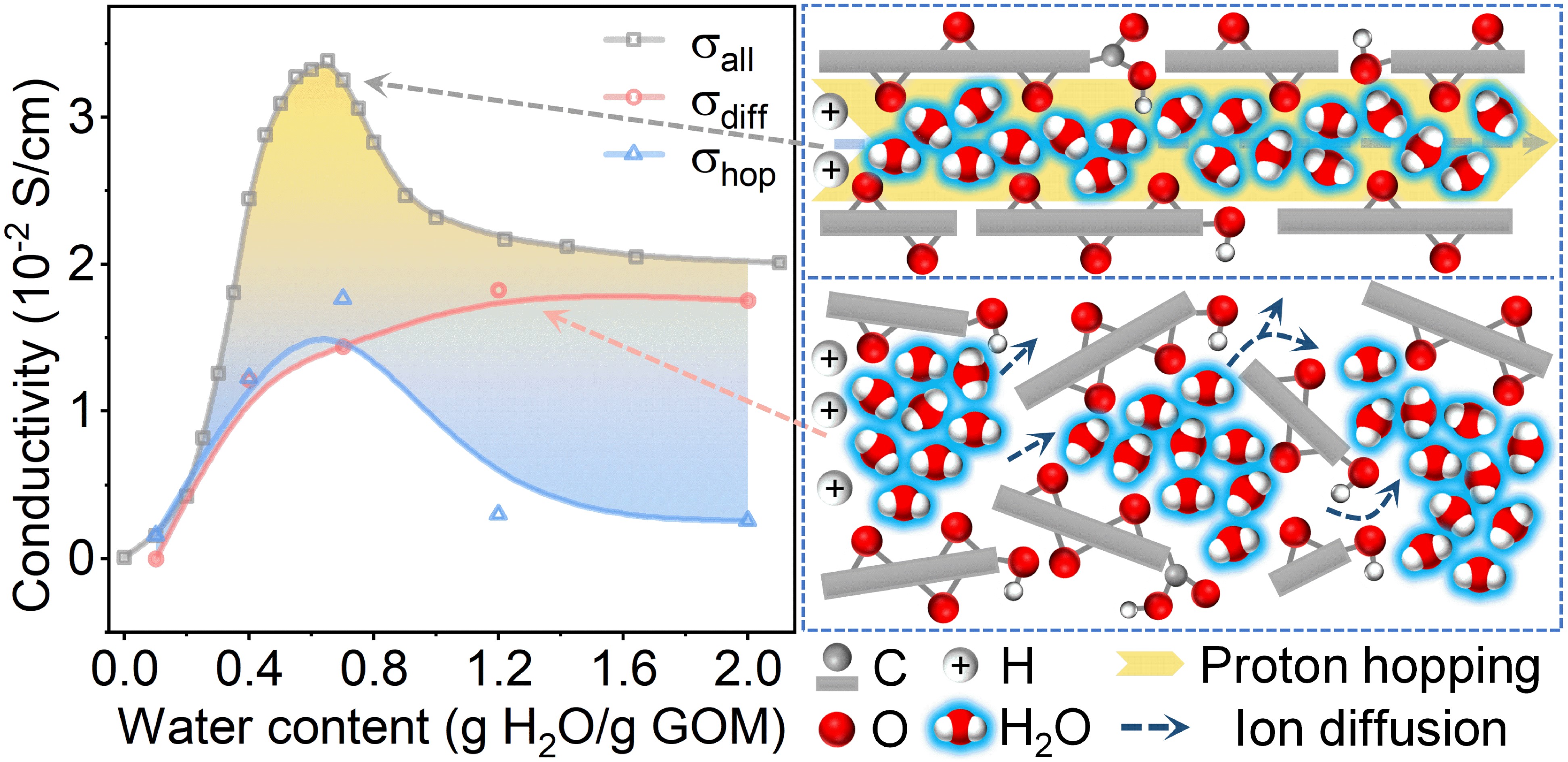← Back
上海交通大学洪亮课题组发表关于氧化石墨烯薄膜的质子传导机制的研究
2022年8月
近日,上海交通大学自然科学研究院/物理与天文学院洪亮教授课题组利用中子散射等多种实验手段,研究了氧化石墨烯薄膜的质子传导机制。实验结果表明,质子跳跃和离子扩散这两种导电机制对传导过程的贡献是能够被定量区分的,且氧化石墨烯薄膜电导率与其层间水分子层数的对应关系揭示了导电机制随含水量变化由质子跃迁转变为离子扩散主导的原因。研究成果以“Conduction mechanism in graphene oxide membranes with varied water content: From proton hopping dominant to ion diffusion dominant”为题发表在美国化学学会的《ACS nano》期刊上。

图:氧化石墨烯薄膜电导率随含水量的变化及其在特定含水量下的微观结构示意图
质子导体,特别是水合固体质子膜,被广泛应用于传感器、燃料电池,催化剂和细胞生物系统等领域。目前,科学家们已经提出了两种质子传导机制。一是质子沿着氢键网络跳跃,即Grotthuss机制(质子跳跃),二是质子以水合氢离子的形式扩散,即Vehicle机制(质子扩散)。尽管学者们已经通过实验和模拟计算广泛研究了这两种机制,但质子在复杂环境,例如材料界面和受限空间内的传输机制仍然难以确定。因此,揭开材料内在的质子传输机制,明确其与周围水环境的对应关系,从而提高质子传输效率,实现材料的最佳功能化应用十分重要。
本工作利用中子散射、XRD、SEM、DSC、阻抗仪等多种实验手段,探究了二维层状结构的氧化石墨烯薄膜电导率与其含水量的对应关系。研究发现:质子跳跃机制在低含水量下占主导地位,而离子扩散机制将随着含水量的增加而开始占据主导地位。由于水分子可以进入氧化石墨烯薄膜层间,其层间距随含水量逐渐变大。所以当含水量小于0.7时,其层间可以容纳两层水分子,水分子和含氧官能团彼此联结形成氢键网络,质子可在其网络内部实现跳跃,从而电导率达到最大。当含水量高于0.7时,两层以上的水分子进入层间,体态水的出现导致有序的二维层状结构的破坏,质子就会在氧化石墨烯薄膜的面内和面外两个方向扩散,导致电导率开始下降。
更重要的是,我们利用准弹性中子散射技术得到了离子扩散电导率,利用阻抗仪得到材料的整体电导率。质子跳跃机制贡献的电导率可根据上述两者得到。所以我们从实验角度发现两种传导机制共同作用于氧化石墨烯薄膜的导电过程,且它们对整体电导率的贡献随含水量的变化而占比不同。这些发现为水分子参与调控的质子导体材料提供了一种优化策略,即通过调节其水含量实现材料的快速质子传输。
上海交通大学材料科学与工程学院博士生张磊为本文第一作者,自然科学研究院/物理与天文学院/张江高等研究院洪亮教授为通讯作者,自然科学研究院助理研究员刘卓为共同通讯作者。中子散射实验得到了英国科学与技术设施委员会ISIS中子和介子设施谱仪科学家Victoria García Sakai和美国国家标准与技术研究所NIST中子研究中心谱仪科学家Madhusudan Tyagi的技术支持。该工作得到了国家自然科学基金委、上海市科委、教委以及上海交通大学分析测试中心和上海交通大学学生创新中心的支持。
Proton conductors have widespread applications in fuel cells, sensors, catalysts, batteries, etc. The fast proton transfer is paramount to achieve the optimal functionalization of the materials. Up to now, two conduction mechanisms have been proposed for proton conduction. One is that protons hop along the hydrogen bond network (HBN), namely the Grotthuss mechanism (proton hopping), and the other is that protons can diffuse in water by the form of hydronium ions, namely the vehicle (diffusion) mechanism. These two mechanisms have been extensively studied in light of the nature of the microscopic state by simulations and experiments. However, the transport mechanism of protons in material interfaces and confined nanochannels remains elusive due to the more complex system environments.
In this work, we study the proton conduction mechanism in hydrated laminar GOM by QENS and IA measurements. The results allow us to quantitatively separate the contributions of these two mechanisms, namely proton hopping and ion diffusion, to the conduction process. The relationship between electrical conductivity and the layers of water molecules inside GOM nanosheets reveals the dependence of the conduction mechanism of GOMs on water content, that is, shifting from proton hopping dominant to ion diffusion dominant with increasing GOMs water content. These findings are necessary for applications of materials such as sensors, fuel cells, and cellular biological systems, where their surface and interface properties are affected by water molecules. Furthermore, our results may lead to the manipulation of water molecules in the hydrated solid membrane by controlling its water content to achieve fast proton transport.
The first author of this article is a PhD student Lei Zhang from school of materials science and engineering. The corresponding authors are Prof. Liang Hong from School of Physics and Astronomy, Institute of Natural Sciences and Zhangjiang Institute for Advanced Study and Dr. Zhuo Liu from Institute of Natural Sciences. The neutron scattering experiments were carried out with the help of Dr. Victoria García Sakai at ISIS in the United Kingdom and Dr. Madhusudan Tyagi at NIST in the United States. The work was supported by National Natural Science Foundation of China, Shanghai Municipal Science and Technology Major Project, Instrumental Analysis Center and Student Innovation Center of Shanghai Jiao Tong University.
